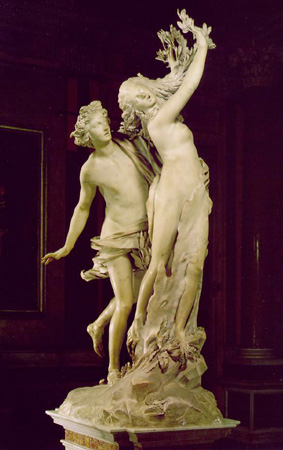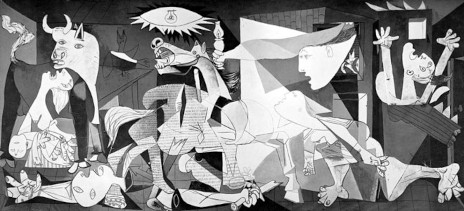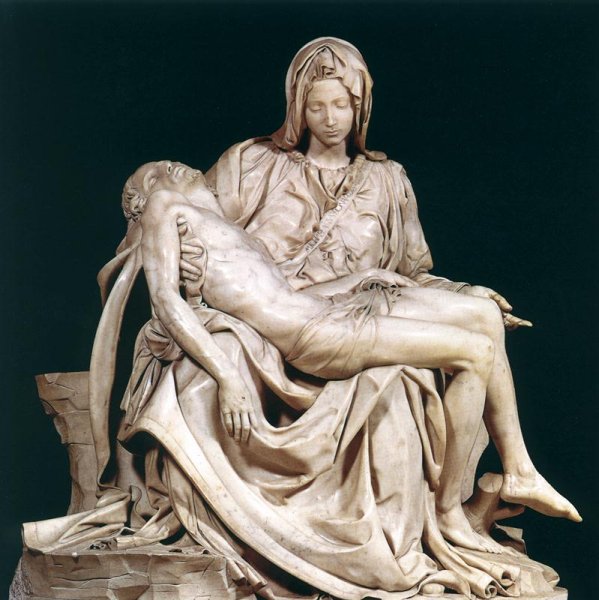
The full story is in Ovid, Metamorphoses, Book I, 457-556
Modern "art" is an abomination that can be duplicated by hogs, chimps, and elephants.
Seriously! I've seen video of a chimp doing paintings that look just like that splatter crap done by Jackson Pollard.
Everyone perceives the cosmos in a unique and personal way. The goal of the artist is to relate to another human being his own particular perception of the cosmos, and do it in a way that his own experience is reproduced in the mind of the person beholding his work. Deliberate obfuscation, of the type seen in modern art, is antithetical to the concept of art. The idea is to communicate things that are too personal and abstract to communicate by way of simple narrative.
They turn their backs on such works, go home, and watch television, and it's magic pixels, all arrayed in lines and columns, mixing only 3 colors to produce millions of colors, and feel smug in their assurance that they know all there is to know about how images are created, and what they mean.
Today's artists seem to be more concerned with 'statements', 'expression' and self absorption than with beauty or art.
bttt
Printed out for further study (and I bookmarked your homepage for further study too).
fyi - (plus you usually post such interestingly wonderful images on these threads)
Meanwhile, real art is tossed aside as bourgeois, common. Yes, the Emporer has been without clothes for quite some time. The money and the mutual admiration society they have keep modern art going. Even those who feel they've been taken won't give up the facade (what? and cheapen their 'investment'?). Why would they want to give up on a good thing? Ch-ching.
Seems the patrons' appreciation of this "art" was based solely on how weird the artist was.

The full story is in Ovid, Metamorphoses, Book I, 457-556
Art Ping.
Let Sam Cree or I know if you want on or off this list.
I have no time to read this article at the moment, but I will later and duly respond.
 |
 |
| Art | Garbage |
Yes, one can always "appreciate" art just for its visual appeal, be it Matisse or Botticelli. But that may be a more superficial level. One can gain a deeper intellectual, visual and emotional understanding if one digs a bit deeper.
Let's look at two prime examples: Botticelli's Primavera from 1482 and Picasso's Guernica from 1937.


Right off, one can tell that the subjects are different and that there are different emotional impacts. So, if you don't know anything about these works, what can you learn just by looking? If you know Italian, you can tell that Botticelli's work is about spring. There is a pretty girl in the middle and something weird happening to a woman on the right.
Many art historians have in fact argued (very eruditely) about what this work means and who these people are. The explanation I like is that this is not only about spring but about three different stages of love. The West Wind (Zephyr) comes in from the right and represents March; Mars, symbol of May, raises his object on the left and stops the sweep of Spring. On that right, Zephyr has also abducted Chloris and, after the “seduction” (or rape), she becomes Flora the Roman goddess of flowers. This represents sexual love. Off center to the left, the three Graces (showing all sides important to men’s eyes, underneath very skimpy drapery) represent platonic love, with several symbolic interpretations to the height of their hands. The lady in the middle is Venus and looks uncannily like a woman who was engaged to a Medici (THE rich family in Florence, where Botticelli was painting). Mars looks a great deal like a young Medici of the time. One interpretation is that this is a wedding painting for them, with symbols of various kinds of love. Thus the central lady is a rather virtuous Venus (since she is clothed) who will be married to Mars. She represents marital love. There is even more symbolism: from the oranges to the designs on her drapery, but they can all support this interpretation.
Did you get all that by looking at the painting? I sure didn’t. I only know it because I’ve taught it a zillion times.
Lastly, is Botticelli perfectly “realistic?” No. No drapery falls like that. He has changed things, perfected his forms to an ideal. His use of line is incredible: weaving and winding and flowing in lovely (but totally unrealistic) ways. There’s nothing wrong with that; he is to be applauded by not being constricted to “realism” from the real world and for pushing his own style to “say” something else. (One could also dive really deeply into Neoplatonic philosophy, to which Botticelli was devoted, and make those connections with this painting, but I will spare you….)
And what is going on in Picasso’s work? Can you decipher anything? You may be able to decipher here more than you think, and more than you can in the Botticelli. What does the bull represent? (The bull may represent Spain, or even Franco, the soon-to-be dictator of Spain.) What is going on with the woman and child in the left? If you are saying the woman is upset because her child is dead, you are right. This also connects to many images of Mary with the Christ Child in her lap, as child and as adult. I also think that the spike in this woman’s mouth, and in the horse, as well as the distortions of their heads, can convey physical and emotional pain even more strongly than in any representational image.
What’s happened to the soldier lying in the middle? Yes, he is dead; but note the flower in his hand; this give a sense of hope as well as fragility. What is that light in the middle? Could it also be seen as a sun and as an eye? Definitely. The woman on the right with the torch is coming in to light up the scene; note the horse has a newsprint texture. This painting (which is HUGE) was done after Franco called in the Germans to help with the Spanish Civil War. This was the first use of saturation bombing, where more civilians were killed than military personel, and a town with no military significance was bombed almost out of existence. This kind of bombing turned out to be a main event in WWII. This is a black and white painting, although one of my students (who saw it in person in Madrid’s Prado) could have sworn there was blood red in it! (This internet image is a bit too blue…sorry about that.)
Other images of Mother and Child and Pieta images.

.jpg)
Michelangelo: two Pietas, one early, one late; Raphael Alba Madonna
Pieta, by the way, is a fancy word for pity and was a subject (not in the Bible) that was devised by artists to bring the most compassion for Christ after his death, lying in Mary’s lap.
Now, be honest….which piece really moves you, affects you and reflects the events of the 20th century? When Einstein came up with his theories of relativity, time, life and art changed. More about this later on. But the really cool thing about early modern art is that certain symbols (like that lightbulb in Picasso) can represent many other things as well.
Also, I wish the author, Claudio Lombardo, would use more discrimination in the labeling of art. "Modern" is not just art of the whole twentieth century. "Contemporary art," that art after 1950 or 1960, is probably more relevant to the disgust the viewer feels.

That image is the Broken Kilometer by de Maria, 1970s. This is installed in NYC and is parts of a kilometer broken up. Not a lot of depth here; even I don’t think this is a great work of art. This is contemporary site work and is, in retrospect, rather gimmicky and empty. I don’t have a problem being critical with this kind of work, and I think that Lombardo means this kind of work when he attacks “modern” art. But more discrimination of terminology would be appreciated.
Unfortunately, I think this writer has such an axe to grind that he has closed himself off to all other possibilities.
I wish Mr. Lombardo could have defined what he meant by modern art.
OTOH, I just leafed through the entire MOMA painting collection online without seeing much that I liked, and only a couple things I think are "great." Not much skill displayed, IMO.